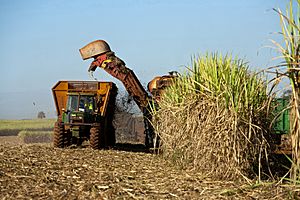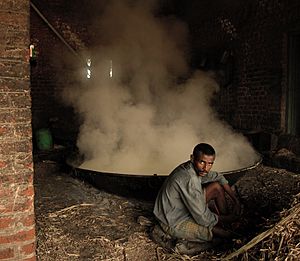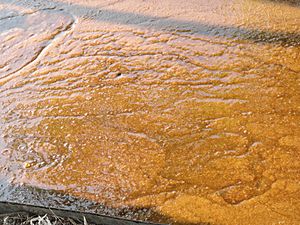Jaggery facts for kids
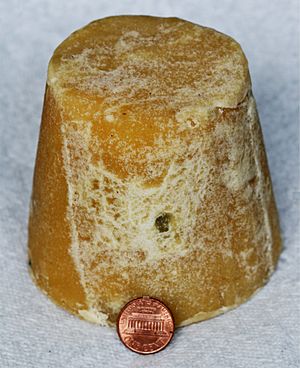
A block of jaggery with a US penny for size comparison
|
|
| Place of origin | India |
|---|---|
| Main ingredients | Sugarcane juice, boiled and concentrated. |
| Similar dishes | Panela, palm sugar |
Jaggery is a traditional type of sugar that is not fully refined. It's popular in places like India, Southeast Asia, and parts of Africa. Jaggery is made by boiling and concentrating the juice from sugarcane or the sap from date and palm trees. Unlike regular sugar, it keeps its natural molasses and crystals, which gives it a color from golden to dark brown.
Jaggery contains about 50% sucrose (the main sugar), up to 20% other sugars, and some moisture. It also has small amounts of other natural things like plant fibers. Jaggery is quite similar to another type of sugar called muscovado.
Contents
What is Jaggery and Where Does it Come From?
Jaggery is a special kind of sugar made from two main sources: sugarcane plants and the sap of toddy palm trees. Sugar made from date palm sap is often considered more special and is harder to find. Toddy palm trees are tapped for jaggery in countries like India, Bangladesh, Pakistan, Nepal, Myanmar, and Sri Lanka.
In Sri Lanka, a tree called kithul (which is a type of palm) is widely used to make jaggery syrup.
All kinds of jaggery are sold as solid blocks or thick pastes. These are made by heating concentrated sugar syrup to a very high temperature, around 200 degrees Celsius (392 degrees Fahrenheit). Traditionally, people boil the raw sugarcane juice or palm sap in large, shallow, round pots.
How is Jaggery Made?
Making jaggery involves a few steps. In the past, farmers used machines powered by oxen to crush sugarcane. Today, most crushers use engines. These machines are usually set up right in the sugarcane fields.
First, the cut and cleaned sugarcane is crushed. The juice that comes out is collected in a big container. Then, some of this juice is moved to a smaller pot and heated over a furnace.
The juice is heated for about an hour. Often, dried wood pulp from the crushed sugarcane is used as fuel for the furnace. As the juice boils, a small amount of lime is added. This helps any wood particles or impurities rise to the top as a foam, which is then skimmed off.
Finally, the juice gets very thick. The hot liquid becomes golden and is about one-third of its original amount. Workers stir it constantly and lift it with a spatula to check its thickness. If it forms many threads when it drips, it's ready.
The thick liquid is then poured into a large, flat pan to cool down and become solid. The pan is very wide, allowing the liquid to spread thinly. This helps it cool and dry quickly. Once it cools, the jaggery becomes a soft solid. It can then be shaped into blocks or other forms.
The color of jaggery often shows its quality. Brown jaggery usually has more impurities, while golden-yellow jaggery is considered purer. Because of this, sometimes colors are added to make jaggery look more golden.
How Jaggery is Used
In South Asia (Indian Subcontinent)
Jaggery is a common ingredient in many sweet and savory dishes across India, Pakistan, Bangladesh, Nepal, Sri Lanka, Afghanistan, and Iran. For example, a little bit of jaggery is sometimes added to dishes like sambar and rasam in Udupi cuisine. In Gujarati cuisine, jaggery is often put into lentil soups (called dāl) to add sweetness and balance out spicy, salty, and sour flavors.
In Sri Lanka, jaggery is usually made from the syrup of the kithul palm tree or from coconut syrup. These are known as kitul hakuru and pol hakuru. Jaggery from the Palmyrah palm is popular in the northern part of the country, called thal hakuru. Sugarcane jaggery is not as popular there.
Maharashtra in India is a huge producer and user of jaggery, where it's called "gul" in Marathi. It's also known by different names in other Indian languages, like "gur" in Urdu and Hindi, "bellaṁ" in Telugu, and "Vellam" in Tamil.
Kolhapur in India is famous for its jaggery and even has a special GI Tag for it. Many vegetable dishes, curries, and dals, along with many desserts, use jaggery. It's especially used during the Makar Sankranti festival to make a dessert called tilgul. In Gujarat, a similar sweet called tal na ladu is made.
In rural Maharashtra and Karnataka, people offer water and a piece of jaggery to someone coming home after working in the hot sun. Jaggery-based sweets are also made for New Year celebrations in Indian culture. For example, during the Ugadi festival in Andhra, Telangana, and Karnataka, a dish called Ugadi Pachadi is made with jaggery and five other flavors. This symbolizes that life is a mix of different experiences.
Molasses (called kakvi), which is a leftover product from making jaggery, is used as a sweetener in rural Maharashtra and Karnataka. It has many minerals and is thought to be good for health in traditional Ayurvedic medicine. It's also an ingredient in many sweet treats, like gur ke chawal ("jaggery rice"), a traditional dish from Rajasthan or Punjab.
In Gujarat, laddus (sweet balls) are made from wheat flour and jaggery. A well-known Maharashtrian dish, puran poli, uses jaggery as a sweetener. Jaggery is seen as an easy-to-get sweet that is shared on happy occasions. In engagement ceremonies, small pieces of jaggery are mixed with coriander seeds. This is why many Gujarati communities call an engagement "gol-dhana," which means "jaggery and coriander seeds."
Jaggery is used a lot in South India to balance the strong taste of spicy foods. In Andhra Pradesh and Tamil Nadu, it's used for sweets like chakkara pongal and milk pongal. During the Pongal festival, Ariselu is prepared in Andhra Pradesh. In Tamil Nadu, ellurundai (sesame balls) and other sweets are made as offerings to gods during festivals like Diwali.
A sweet drink called "Paanakam," made with water, jaggery, and peppercorns, is a favorite offering to Lord Rama during the Rama Navami festival. In Kerala, jaggery is considered lucky and is widely used in cooking. It's a key ingredient in many types of payasam, a sweet dish.
In Tamil Nadu, jaggery is used only as a sweetener. It's in a dish called chakkarai pongal, made during the Pongal festival when harvesting begins. It's also used to make kalhi, to sweeten fruit salads, and in payasam (sweet milk) offered to gods. Jaggery is part of religious ceremonies. In villages, cane jaggery and palm jaggery are used to sweeten drinks, but in cities, refined sugar is more common.
In Odia cooking, cakes or piṭhas often contain jaggery. For example, Arisa pitha is made with jaggery (called guda in Odia). Kakara pitha has coconut fillings sweetened with jaggery. Jaggery is also added to rice flakes, called chuda, for breakfast. Some jams made from mango and dillenia also use jaggery.
In Bengali cooking, jaggery is commonly used in sweet dishes, sometimes mixed with milk and coconut. Popular sweets like laḍḍu or paṭishapta piṭha mix jaggery with shredded coconut. Jaggery is also shaped into candies. Similar sweets are made in Assam. Some popular Assamese sweets like til-pitha (made from rice powder, sesame, and jaggery) and payas use jaggery. In some Assamese villages, people drink salty red tea with a cube of gurd (jaggery), which they call cheleka-chah (licking tea).
Traditional Karnataka sweets, such as paayasa, obbattu (holige), and unday, use different kinds of jaggery. A small amount is often added to sambar and rasam. Karnataka produces both sugarcane and palm-based jaggery.
Muzaffarnagar in Uttar Pradesh, India, has the world's largest market for jaggery. Anakapalle in Andhra Pradesh is also a major market. The Kolhapur District in western Maharashtra is famous for its yellow jaggery, which is very popular in Maharashtra and Gujarat. Mandya in Karnataka is also known for making jaggery.
In Southeast Asia
In Myanmar, jaggery is called htanyet in Burmese. It's made from toddy palm syrup. In central Myanmar, especially around Bagan, toddy syrup is collected just for making jaggery. The clear syrup is boiled until it turns golden brown and then shaped into small, bite-sized pieces. It's a popular sweet snack for both kids and adults, often eaten in the afternoon with green tea. Some people call it Burmese chocolate. Toddy palm jaggery is sometimes mixed with coconut shreds, jujube puree, or sesame, depending on the area. This type of jaggery is used in Burmese cooking to add color and flavor to food.

Other Uses for Jaggery
Jaggery is used to make jaggery toffees and jaggery cake, which can include pumpkin preserve, cashew nuts, peanuts, and spices. It can also be used in making alcoholic drinks like palm wine.
Beyond food, jaggery has other interesting uses. It can be mixed with buttermilk and mustard oil to season the inside of tandoor ovens. Jaggery is also used in the natural dyeing of fabrics. In rural areas of Pakistan and India, it's sometimes used in hookahs.
Jaggery can even be used in medical labs to prepare tissues for examination.
Names for Jaggery
Jaggery has many different names depending on the language and region.
In the Indian Subcontinent
- In Bengali, Bhojpuri, Punjabi, Haryanvi, and Hindi, it's often called guṛ.
- In Assamese, it's gur or mithoi.
- In Sindhi and Urdu, it's ɠuṛ.
- In Odia, it's guṛô.
- In Konkani, it's goḍ.
- In Marathi, it's guḷ.
- In Gujarati and Rajasthani, it's gôḷ.
- In Pashto, it's gwëṛa.
- In Tamil and Malayalam, it's vellam or panai vellam.
- In Telugu, it's bellam.
- In Kannada and Tulu, it's bella.
- In Malayalam, śarkkara or cakkara is also used.
- In Tamil, sakkarai is used.
- In Nepali, it's sakkhar or bheli.
- In Sinhala and Dhivehi, it's hakuru.
- In Malayalam, karuppaṭṭi is jaggery from palm juice, and panam kalkaṇḍam is palm juice rock candy.
- In Tamil, karupaṭṭi or panam kalkaṇḍu is used.
In Southeast Asia
Cambodia

- In Khmer, it's Skor tnaot.
Myanmar (Burma)
- In Burmese, Htanyet means Toddy Palm Jaggery, and Kyan Tha Kar means Sugarcane Jaggery.
Malaysia
- In Malay, it's Gula melaka or Gula merah.
- In Kelantanese Malay, it's Gula nisan/nise.
- In Sarawak, Malaysia, Gula apong is a type of jaggery from the sap of the nipah palm.
Indonesia
- In Indonesian and Javanese, it's Gula jawa.
- In Indonesian and Malay, it's Gula merah.
- In Indonesian and Betawi, it's Gula aren.
- In Sundanese, it's Gula kawung.
Philippines
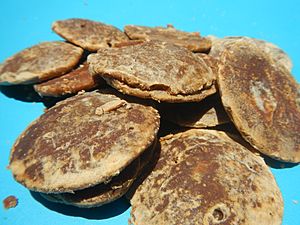
- In Ilocano, it's Tagapulot or Koya-Koya.
- In Kapampangan, it's Pakombuk.
- In Philippine Spanish, it's Panocha.
- In Tagalog, it's Panutsa or Sangkaka.
- Bagkat Bao might be specific to Bulacan (Tagalog).
- In Leyte and Samar (Waray-waray), it's Calamay.
Thailand
- Palm jaggery: Thai: น้ำตาลโตนด, romanized: namtan tanot
- Coconut jaggery: Thai: น้ำตาลมะพร้าว, romanized: namtan maphrao
- Cane sugar: Thai: น้ำตาลอ้อย (งบน้ำอ้อย), romanized: namtan oi (Ngob Nam Oi)
- Granulated brown cane sugar: Thai: น้ำตาลทรายแดง, romanized: namtan sai daeng
- Granulated white cane sugar: Thai: น้ำตาลทราย, romanized: namtan sai or Thai: น้ำตาลทรายขาว, romanized: namtan sai khao
Elsewhere
- Raspadura in Cuba and Panama.
- Rapadura in Brazil.
- Panela in Central America and parts of South America.
- Piloncillo in Mexico.
- Tapa de dulce in Costa Rica.
- Chancaca in Peru.
- Papelón, panela or miel de panela in Venezuela.
- Sukari nguuru in Swahili.
- Kokuto (黒糖, Kokutō) in Japanese.
- 紅糖 (hóng táng) or 黑糖 (hēi táng) in Chinese.
- Gur in Afghanistan.
Images for kids
-
Jaggery (gur) making at small scale near sugarcane farm in Pakistan.
-
Transferring boiled sugarcane juice into vessel to dry.
-
Gur mamra laddu sweets made from jaggery and puffed rice.


